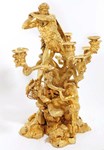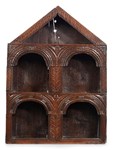
Thirty years ago a watershed in the art market was reached. On March 30, 1987, Vincent van Gogh’s Still Life: Vase With 15 Sunflowers sold at Christie’s in London for $39.9m (including premium).
It tripled the auction record for any art work and, in doing so, hit the headlines worldwide. The purchase highlighted the new breed of wealthy buyers in the art market and showed that museums could no longer compete with private buyers for major works.
Van Gogh (1853-90) is one of the most famous painters of all time, considered the greatest Dutch artist after Rembrandt and his works are now among the most reproduced.
Even Amsterdam’s Van Gogh Museum is getting in on the act.
Partnering with Fujifilm Europe and distributor Tribute International, it has produced a series of prints of nine works recreated with threedimensional technology to replicate the way van Gogh applied thick layers of paint.
The patented technology is called Reliefography and the Amsterdam museum has authorised, certified and numbered the limited edition of 260 of each of the nine paintings selected.
It is selling the majority (prices are in the region of £22,000 plus tax), but 50 will stay with the museum for research purposes.
With more imitations and reproductions of van Gogh’s work, across many mediums, where do these prints fit into the tortured artist’s oeuvre? Van Gogh’s greatgrandnephew, Willem van Gogh, an ambassador for the museum, explains why the launch of the Editions series would have had the approval of the artist himself.
ATG: With so many copies of van Gogh’s famous paintings, why is the museum adding to such reproductions with this series of Editions?
WvG: The museum lives from ticket sales. But we needed other services to maintain our original collection to continue van Gogh’s legacy.
Some may think you are cheapening the van Gogh name by reproducing his work in this way.
Everyone is free to reproduce what they like as van Gogh is out of copyright. But the works in our Edition collection need the original to create the texture and colour. We are the only people who own 200 works, so we have that sense of responsibility.
These new works are the second best option to owning a van Gogh.
There are 860 paintings by the artist in the world, but 650 are in museums or public collections. There are only 200 in private hands. His works are either not affordable or no longer available so this is a way to own one.
It’s also important to note that Vincent planned for reproductions.
In a letter he sent in 1882, eight years before his death, to his brother Theo, my great-grandfather, he suggested he would like to see his paintings made available to all people in the form of prints.
Do you see the van Gogh name – your family name – as a brand?
Not my name, but yes, he is the most famous artist ever. From the 1980s, adverts (using images of his artworks) have brought a lot of hype. This was when the Sunflowers sold for the record amount paid for a piece of art.
So yes, ‘van Gogh’ is a brand name now. This trend was perhaps started by Andy Warhol and we see it now with Jeff Koons.
Critics say the contemporary art market is just about money and not art. Do you think that is true?
It wasn’t about money when Vincent was painting. He wanted to share his art with everyone.
But even the people who are buying artworks for millions have a passion. They would not spend so much if they did not. The Japanese buyer [Japanese insurance tycoon Yasuo Goto] of the Sunflowers could talk for hours on the topic. You don’t spend that much money for nothing!
Last year the Van Gogh Museum issued a public rebuttal on the release of a sketchbook over the question of authenticity (ATG No 2270). Was this an attempt to control the market?
No. We do not have an interest in the market [of preventing the discovery of new works] because we are not going to sell our pieces. Since we are the main centre of knowledge for Vincent van Gogh, his art and his life, it is one of our responsibilities [to check authenticity of discovered works].
We like to do this. Five or six years ago we examined a painting for two years and it appeared to be real. Adding another painting to his oeuvre made us all very happy.
But it is a complicated job. We have perhaps 200 pieces coming to us every year [claiming to be by Vincent]. Analysing such pictures takes a long time.
Can the museum ever hope to buy a new van Gogh?
How would we fund a purchase of hundreds of millions of pounds?
Maybe one day.
Do you have a favourite painting?
The Almond Blossom is very important to our family. It was a gift for Vincent’s brother Theo and wife Jo, who had just had a baby son, Vincent Willem, my grandfather, who founded the Van Gogh Museum and was named after Vincent.
Willem van Gogh
Curriculum Vitae
1982-86
Rijks Universiteit, Groningen, Netherlands
1986-99
Lawyer at Trip Advocaten, Groningen
1999
Joins the Van Gogh Museum in Amsterdam with responsibility for its retail division
2009
Advisor to the board and works as an ambassador for the Van Gogh Museum














